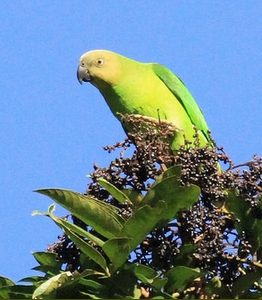Singing Parrot |
|
|
Also known as: Song Parrot, Yellow-headed Parrot, Yellow-headed Song Parrot
Photos
View in GalleryDid You Know?
It is theorized that the Geoffroyus genus of parrots, to which the Singing Parrot belongs, are closely related to the Psittacula parakeets, which includes Ringneck and Alexandrine Parakeets.Academic Research
Related publications: Geoffroyus heteroclitusSpecies Profile
Genus: Geoffroyus | Species: heteroclitus
Size:
25cm (9.75 in)
Weight:
160-195g (5.6-6.8 oz)
Subspecies including nominate:
two: G.h. heteroclitus, G.h. hyacinthinus
Colour Adult:
G.h. heteroclitus: Male-in general green in colour; yellow head; collar around neck grey/lilac; blue underwing coverts; yellow upper mandible, grey lower mandible. Eye ring grey. Eye yellow. Female-grey head, blue collar absent. Bill grey.
G.h. hyacinthinus: Male-collar extending to mantle and lower breast mauve/blue and less grey, occasionally to flanks and abdomen; bluish bend of wing; very visible bluish margins to primary coverts. Female-blue/grey of head darker and reaching to neck and cheeks; very visible bluish margins to primary coverts.
Colour Juvenile:
G.h. heteroclitus: As in adult female but crown washed with green. Bill pale grey with dull yellow at base; cere flesh pink instead of grey. Eye ring white. Eye grey.
Call:
Calls are described as raucous and loud, both perched and in flight; also emits high-pitched whistling song consisting of two notes.
Listen NowVideo Links:
Video 1More Information:
Content Sources:
CITES
BirdLife International
Cornell Lab of Ornithology/Birds of the World
Parrots: A Guide to Parrots of the World, Juniper and Parr, 1998
xeno-canto Song Parrot, Krabbe, Niels, XC32822
Parrots of the World, Forshaw, 2006. 2010 edition
Lexicon of Parrots, Thomas Arndt.
Photos
View in GalleryDid You Know?
It is theorized that the Geoffroyus genus of parrots, to which the Singing Parrot belongs, are closely related to the Psittacula parakeets, which includes Ringneck and Alexandrine Parakeets.Academic Research
Related publications: Geoffroyus heteroclitusSpecies Care
Captive Status:
Not commonly found in aviculture.
Longevity:
Not recorded.
Housing:
Enclosure 2.5 x 1 x 2m (8.2 x 3.3 x 6.5 ft), minimum temperature 24C (75F).
Diet:
Offer ripe and unripe banana as well as other fruits such as: apple, pear, orange, cactus fruits; lory porridge made from honey, pollen, oat flakes, brewer's yeast, multigrain flakes, vitamin and mineral supplements; rusk or biscuit softened in milk; small amounts of millet spray, canary seed, oats and some sprouted sunflower; other sprouted seed; complete kibble if taken.
Enrichment:
Not recorded.
Nest Box Size:
Not recorded.
Clutch Size:
Not recorded.
Incubation Time:
Not recorded.
Fledging Age:
Not recorded.
Hatch Weight:
Not recorded.
Peak Weight:
Not recorded.
Weaning Weight:
Not recorded.
Photos
View in GalleryDid You Know?
It is theorized that the Geoffroyus genus of parrots, to which the Singing Parrot belongs, are closely related to the Psittacula parakeets, which includes Ringneck and Alexandrine Parakeets.Academic Research
Related publications: Geoffroyus heteroclitusSpecies Wild Status
World Population:
Unknown. Hyacinthinus ssp very loosely estimated at 5000–20,000 individuals.
IUCN Red List Status:
Least Concern
CITES Listing:
Appendix II
Threat Summary:
A BirdLife “restricted-range” species. Could potentially be affected by habitat loss.
Range:
G.h. heteroclitus: Bismarck Archipelago, Buka and Bougainville Islands, and Solomon Islands, except Rennell Island.
G.h. hyacinthinus: Rennell Island, SE Solomon Islands.
Habitat:
Found up to 600m (1968 ft), locally up to 1750m (5740 ft) in damp, intact lowland and hill forest. Also found in partly cleared forest, forest edge, secondary growth forest and gardens.
Wild Diet:
Diet includes small seeds, fruits, blossoms (ie Cryptocarya sp.) and buds. Apparently both wild and cultivated (unripe) bananas Musa are a staple.
Ecology and Behaviour:
Are often seen singly, in pairs, or small groups. Have been reported mixing with Cardinal Lories and Duchess Lorikeets. Quiet and difficult to detect when hidden in dense undergrowth.
Clutch and Egg Size:
Not recorded.
Breeding Season:
October; female feeding juvenile in August. Nest is in tree cavity or old stump.
Photos
View in GalleryDid You Know?
It is theorized that the Geoffroyus genus of parrots, to which the Singing Parrot belongs, are closely related to the Psittacula parakeets, which includes Ringneck and Alexandrine Parakeets.Academic Research
Related publications: Geoffroyus heteroclitusMembers Only Resources
Please log-in now to find more research, resources and tools.
Not a Member?
Find more great information:
Gain exclusive access to 600+ pages of additional research, seminars and podcasts, specialists to ask your toughest questions, and dozens of other fun resources - when you become a WPT member.
Join Today >>

































